Migratory Birds in Wartime
How Israel’s various conflicts have affected a vital migration pathway
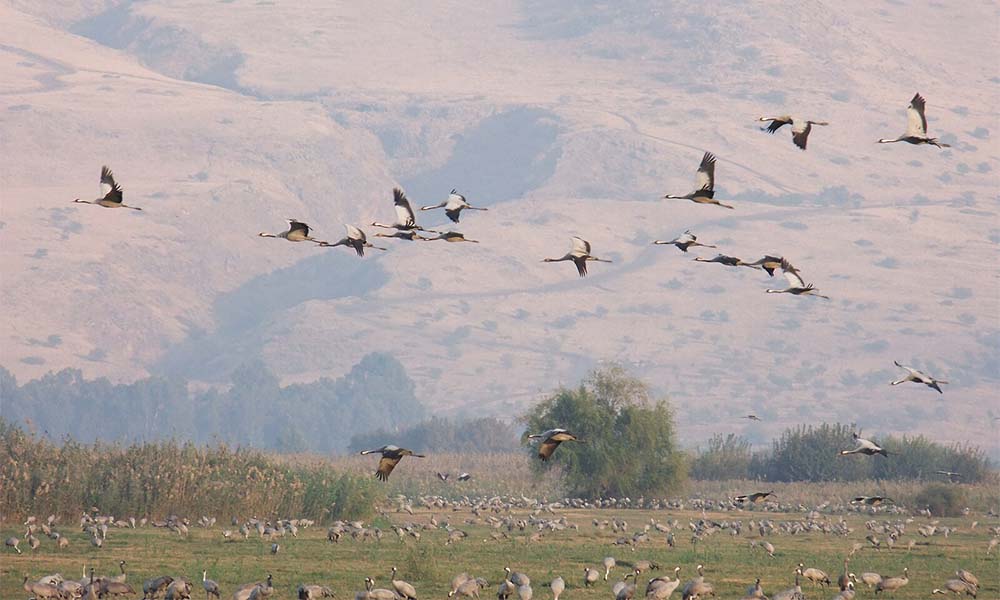
A tiny songbird, weighing just ten grams, rests gently on my hand, as if I’m in a scene from the classic animated Disney movie Snow White. In a flash, the bird flies off, vanishing back into the small wilderness that is the Nili and David Jerusalem Bird Observatory.
Located in the heart of Jerusalem between a cemetery and the Knesset, the 1.5 acre Jerusalem Bird Observatory (JBO) is a fruit-tree-filled paradise that lures a glorious array of migrating songbirds, or passerines, with an opportunity to refuel, says JBO director Amir Balaban. (“Songbird” is the common term for birds in the suborder Passeri, which includes some 4,000 species, owing to their distinctive vocal control.)
Despite the peace of this place, it turns out almost two years of war in the region have been terrible for birds—and of course for humans as well.
Israel is a vital migration pathway for these birds; each year some 500 million migratory birds stop over to roost and feed before flying onward—to Africa in the fall, to Europe in the spring. The observatory facilitates their stay, says Balaban, by cultivating trees that grow nuts that entice birds, such as the Palestine pistachio (terebinth tree), or that attract nutritious mites and bugs, such as the buckthorn shrub.
Early on an April morning, I joined ornithologist Yossi Leshem, emeritus professor at Tel Aviv University, and his colleague Yosef Kiat at the JBO, watching in awe as Kiat weighed and wound tiny coded bands to the legs of colorful songbirds in order to track their movements. The birds are briefly caught in almost-invisible mist nets, woven from very fine threads to blend into the milieu on this patch of wild land. After banding, the birds are released to continue their springtime journey from Africa to Europe.
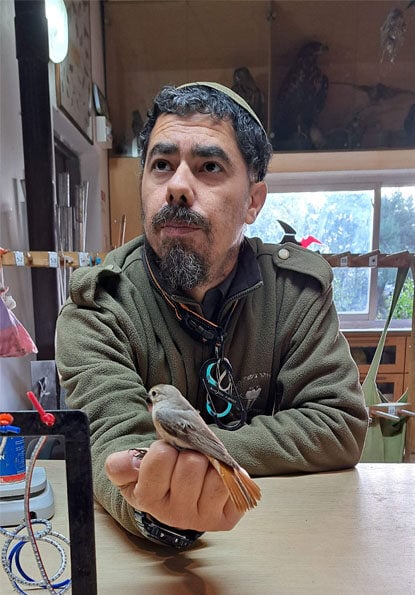
Yosef Kiat at the Jerusalem Bird Observatory. Credit: Josie Glausiusz
In the space of an hour or so, Kiat, a feather expert and senior lecturer at the School of Zoology at Tel Aviv University, rapidly ringed an amazing variety of small bird species, including the grey-winged, white-breasted Orphean Warbler; the olive-feathered common reed warbler; and the redstart, which migrates from the Sahel region of West and Central Africa back to Europe in the spring.
Despite the peace of this place, it turns out almost two years of war in the region have been terrible for birds—and of course for humans as well. Migrating songbirds have seen their feeding grounds shrink as missiles burned forests and fields. Some cranes and pelicans have been shot out of the sky—unintentionally—by anti-ballistic missile technology deployed by the Israeli Air Force. Barn owls, which feed on rodents that ravage agricultural fields, have been driven away when their prey was incinerated.
The loss and exile of these birds is not only a loss of beauty and bounty. Birds play an integral role in maintaining the health and balance of ecosystems. Some species eat agricultural pests, including rodents and insects. Others eat mosquitoes. Some nectar-eating birds pollinate plants; others disperse seeds. Other species scavenge dead animals, preventing the spread of disease.
Birds that pause each spring and autumn on the Levantine land bridge that joins Africa to Europe have been impacted significantly following the October 7, 2023, Hamas terrorist attack and Israel’s subsequent bombardment of Gaza. Hezbollah missiles fired at northern Israel burned 57,000 acres of land, according to the KKL-Jewish National Fund. This devastation extended to coniferous forests where cedar, cypress and pine trees grow.
At the same time, missiles fired by Israel at Hezbollah in Lebanon ignited at least 115 forest and farmland fires, according to data published in July 2024 by ACLED (Armed Conflict Location & Event Data), burning at least 10,000 acres in southern Lebanon. The fires on both sides of the border incinerated not only trees and crops but the seeds and insects on which migratory songbirds feed.
“Small birds fly at night, because at night the weather is better and [there are] not many predators,” Leshem explains. “In the morning they land, and they look for some food. If everything is burned, they cannot stop here. Instead of stopping in Israel and refueling for one or two days, they go to Egypt and eat there.” As Leshem points out, Egypt has a desert or semi-desert environment, so less food is available for migrating birds. And in the autumn, migrating birds do not have sufficient fat reserves to cross the Sahara desert, “so any good feeding in stopover sites is crucial,” he says.
Migrating birds typically navigate through Europe, Turkey, Lebanon and down through Israel each autumn—the latter stages similar to the trajectory of Hezbollah missiles. In the early days of the multiple-front war that broke out after October 7, 2023, some cranes and pelicans were caught in the crossfire of Hezbollah missiles and Israeli air defense systems. These magnificent birds fly at the same height and velocity as drones aimed at Israel by Hezbollah or Iran, sometimes in “swarms” of more than 100 unmanned aerial vehicles (UAVs).
Early on, Israeli radar “couldn’t distinguish between the drones and the birds,” Leshem says. Amidst the tension of war, soldiers manning the radar stations had to rapidly decide whether or not to shoot, and in the confusion they shot at birds, including migrating cranes and pelicans, instead of drones. The missiles, he notes, cost millions of dollars, “which they wasted for nothing.”
Data on the number of birds killed this way is classified. But Leshem notes that in an average year, about 50,000 cranes overwinter in Israel’s Hula Valley; in the period from October 2023 through 2024, the number was reduced to some 15,000. Together with the Israeli Air Force, Leshem is now trying to develop a system that would enable the IAF to distinguish between drones and birds, which could save countless bird lives.
At risk are not only migrating cranes, storks, buzzards and eagles. Barn owls, which have been deployed to replace toxic rodenticides in fields in Jordan and Israel over the past few decades (as part of an international initiative led by Leshem) have also been impacted by missile-ignited fires. The incineration of rodent prey on which the owls feed, together with the ear-splitting noise of bombing, drove the barn owls away.
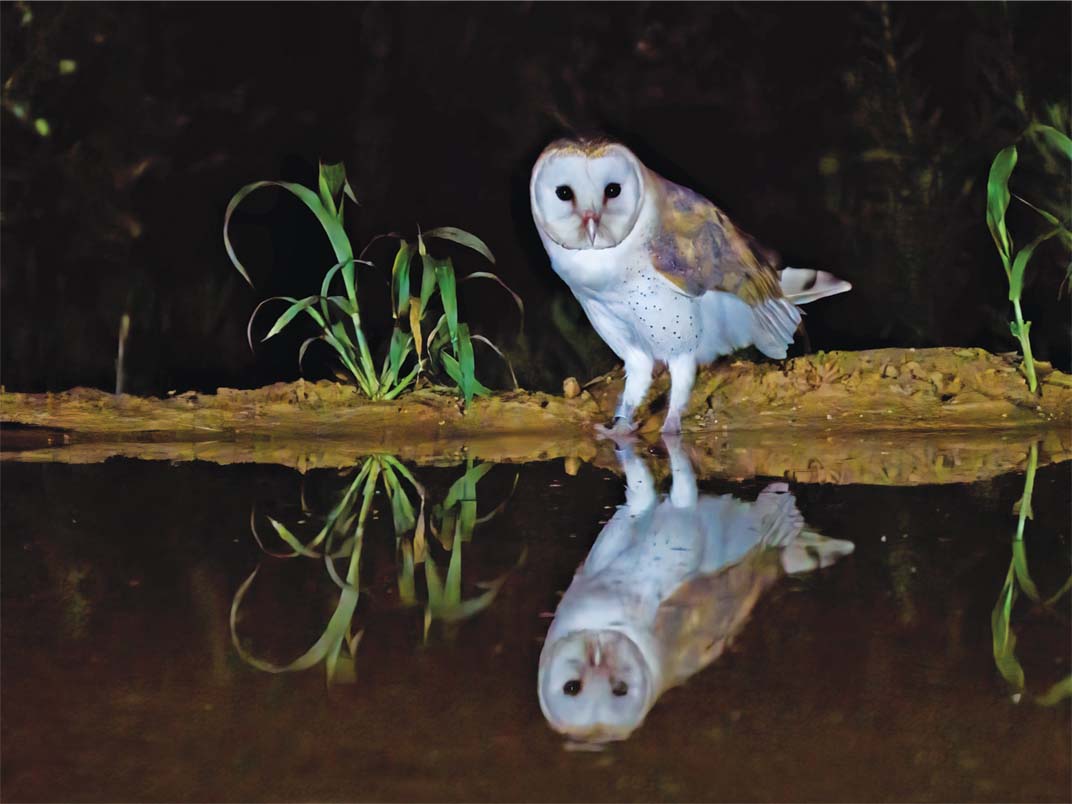
Barn owl. Credit: Shuki Cheled.
Kibbutz Kabri in the Western Galilee, for example, maintained 21 barn owl nesting boxes, 19 of which were occupied in 2023. “This year and last year, how many were occupied? Zero. All of [the owls] left,” Leshem says, adding that it may take years for the greenery to recover and for the barn owls to return. Fires may have also ignited in Lebanon with the Israeli army’s use of toxic white phosphorus munitions. As documented by Human Rights Watch, white phosphorus, airbursts of which can set fire to homes and agricultural areas, were used in at least 17 municipalities across south Lebanon since October 2023. (The Israeli army has said it deploys white phosphorus shells to create smokescreens, not to cause fires.)
The bushfires and forest fires ignited by various kinds of munitions falling in south Lebanon have forced birds to migrate north, says Chadi Saad, manager of the Hima Hammana Raptor Observatory at the Society for the Protection of Nature in Lebanon.
Saad, who describes himself as a birdwatcher and a storyteller, says phosphorus munitions poison soil and groundwater, preventing plant growth even after the winter rains. “The soil is dead,” he says. “Even the trees are dead.” During the fighting with Hezbollah across Israel’s northern border, migratory birds, including storks, European honey buzzards and lesser spotted eagles, did not roost in South Lebanon, “for the first time,” Saad says, due to habitat destruction. Instead, the birds are roosting in the eastern Bekaa Valley and northern Lebanon.
The shrinking of their habitat could have a serious impact, says Saad, pointing out that absence or a decline in bird numbers can lead to a significant imbalance in the ecosystem, “with severe consequences for agriculture, public health, and nature in general.”
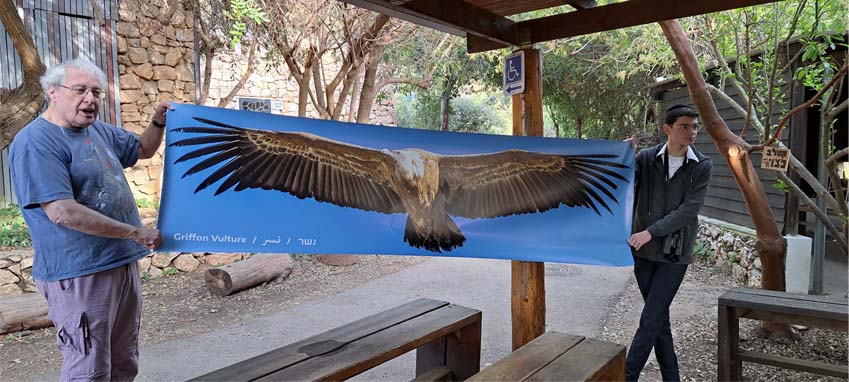
Yossi Leshem with photo of a griffon vulture (to scale) at the Jerusalem Bird Observatory. Credit: Josie Glausiusz
Saad points to another type of war waged on birds, noting that “trophy” hunting of migratory birds is a huge problem in Lebanon. A recent study published in the journal Oryx analyzed photographs posted on social media and estimated that 2.5 million birds are killed each year in Lebanon by poachers, who display their kills on Facebook and Instagram. Among the splayed corpses shared in pictures on social media were 35 species of raptor, including the European honey buzzard, the Eurasian sparrowhawk and the common kestrel.
Saad shares that he is part of an anti-poaching campaign that has rescued many soaring birds and small birds. “But the situation is complicated,” he says. Even when war ends, trophy hunters will continue killing.
It’s probable that the 12-day mid-June Israel-Iran war affected birds in the region as well, although it’s too soon to collect data on its impact. Research led by Judy Shamoun-Baranes at the University of Amsterdam has found that loud booms from New Year’s Eve fireworks in the Netherlands cause birds to flee en masse. Nevertheless, Shamoun-Baranes says she would “find it difficult to make assumptions about how birds would react to the bombing in the Middle East…[overall] I would expect birds to be disturbed and in many cases to take flight.”
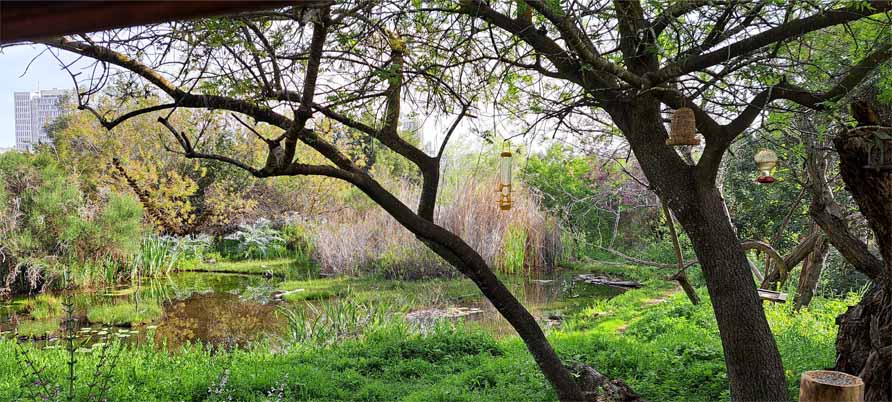
The Jerusalem Bird Observatory in the heart of the city. Credit: Josie Glausiusz
As negotiations for a desperately needed ceasefire in Gaza continue, Leshem’s enthusiasm for bird protection endures. Standing beside a flourishing olive tree planted in 2005 by the late, peace-pursuing U.S. President Jimmy Carter, at the Jerusalem Bird Observatory, the 77-year-old, white-haired ornithologist spreads his arms wide, smiling and admiring the lush and lovely green landscape around him. “This is a haven for migrating birds,” he says.
Top image: Cranes migrating in the Hula Lake region of Israel. Credit: Dror Feitelson (CC BY 2.5)
